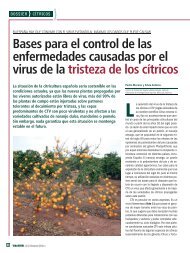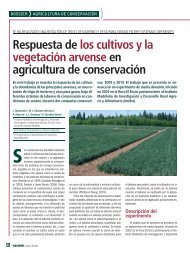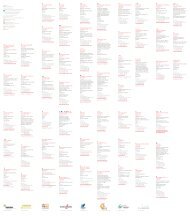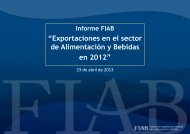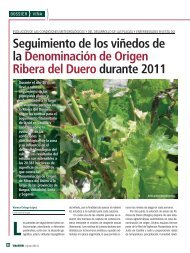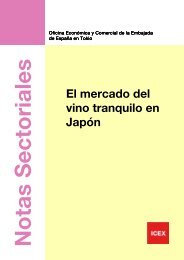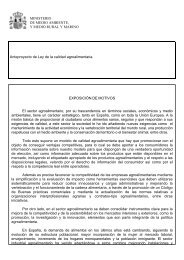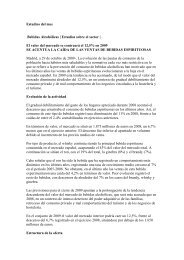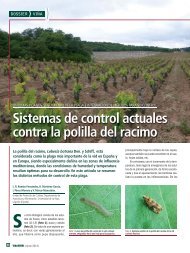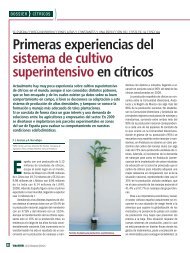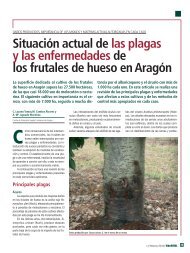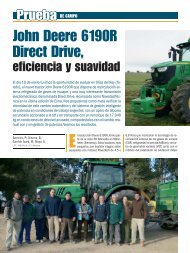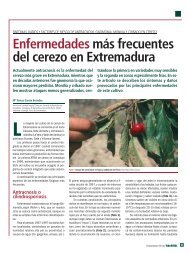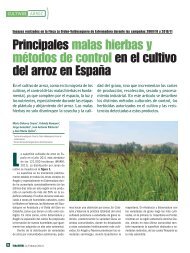Top margin 1
Top margin 1
Top margin 1
Create successful ePaper yourself
Turn your PDF publications into a flip-book with our unique Google optimized e-Paper software.
IP/10/921<br />
Brussels, 13 July 2010<br />
GMOs: Member States to be given full responsibility<br />
on cultivation in their territories<br />
Today the Commission proposed to confer to Member States the freedom to<br />
allow, restrict or ban the cultivation of Genetically Modified Organisms<br />
(GMOs) on part or all of their territory. While keeping unchanged the EU's<br />
science-based GM authorisation system, the adopted package consists of a<br />
Communication, a new Recommendation on co-existence of GM crops with<br />
conventional and/or organic crops and a draft Regulation proposing a<br />
change to the GMO legislation. The new Recommendation on co-existence<br />
allows more flexibility to Member States taking into account their local,<br />
regional and national conditions when adopting co-existence measures. The<br />
proposed regulation amends Directive 2001/18/EC to allow Member States to<br />
restrict or prohibit the cultivation of GMOs in their territory.<br />
Health and Consumer Policy Commissioner, John Dalli said: "Last March, the<br />
Commission promised to present a comprehensive proposal on our future policy visà-vis<br />
GM cultivation by the end of the summer. Today we deliver on that promise.<br />
The concrete measures adopted today will allow Member States the freedom to<br />
decide on GMO cultivation. Experience with GMOs so far shows that Member States<br />
need more flexibility to organise the co-existence of GM and other types of crops<br />
such as conventional and organic crops." The Commissioner added: "Granting<br />
genuine freedom on grounds other than those based on a scientific assessment of<br />
health and environmental risks also necessitates a change to the current legislation. I<br />
stress that, the EU-wide authorisation system, based on solid science, remains fully<br />
in place." To conclude: "This means that a very thorough safety assessment and a<br />
reinforced monitoring system are priorities in GMO cultivation and are therefore<br />
being pursued vigorously. The Commission is committed to follow up actions on<br />
them before the end of the year.”<br />
As of today, a more flexible approach towards cultivation:<br />
The strict authorisation system already in place, which is based on science, safety<br />
and consumer choice, will remain the same.<br />
With the new freedom given to Member States to decide on cultivation, a strong<br />
signal is sent to citizens that Europe takes into account their concerns, which may<br />
vary from one country to another, regarding GMOs. The new approach aims to<br />
achieve the right balance between maintaining an EU authorisation system and the<br />
freedom for Member States to decide on GMO cultivation in their territory. The<br />
proposal delivers on President Barroso's political guidelines, presented in September<br />
2009. Adding this freedom to the legislative framework for GMOs should enable the<br />
authorisation system for GMOs to function effectively. As a first step under existing<br />
legislation, today's new Recommendation on guidelines for the development of<br />
national co-existence measures replaces the previous recommendation of 2003.
The previous Recommendation made a direct link between the establishment of coexistence<br />
measures and the respect of the 0.9% threshold for labelling as GM food,<br />
feed or products intended for direct processing. Member States were advised to limit<br />
co-existence measures (e.g. length of distances between GM and non-GM fields) to<br />
comply with 0.9% GM presence in other crops.<br />
Experience gained over the last years shows that the potential loss of income for<br />
non-GM producers, such as organic and sometimes conventional producers, is not<br />
limited to exceeding the labelling threshold. In certain cases, the presence of GMOs<br />
in certain food products may cause damages to operators who would wish to market<br />
them as not containing GMOs.<br />
The non-binding guidelines included in the new Recommendation on coexistence<br />
better reflect the possibility provided in the existing legislation (Article 26a<br />
of Directive 2001/18/EC) for Member States to adopt measures to avoid the<br />
unintended presence of GMOs in conventional and organic crops. This also allows<br />
for measures aiming to limit GMO content in conventional food and feed to levels<br />
below the labelling threshold of 0.9%. The Recommendation also clarifies that<br />
Member States can establish "GMO-free" area and this new Recommendation<br />
provides better guidance to Member States to develop co-existence approaches.<br />
The European Co-existence Bureau will continue to develop together with Member<br />
States best practices for co-existence as well as technical guidelines on related<br />
issues.<br />
Legal certainty for the future:<br />
The proposal for revising Directive 2001/18/EC aims to secure legal certainty for<br />
Member States when they decide on GMO cultivation on grounds other than those<br />
based on a scientific assessment of health and environmental risks. To this end, the<br />
Commission proposes to include a new article (26b), which would be applicable to<br />
all GMOs that will be authorised for cultivation in the EU, either under Directive<br />
2001/18/EC or under regulation (EC) N°1829/2003. Member States will be able to<br />
restrict or prohibit GMO cultivation in part or all of their territory without recourse to<br />
the safeguard clause. Their decisions will not need to be authorised by the<br />
Commission, but Member States will have to inform other Member States and the<br />
Commission one month before the adoption of their measures. The Member States<br />
will also have to respect the general principles of the Treaties and the Single Market,<br />
and be consistent with the international obligations of the EU.<br />
At the same time, the EU authorisation system, based on scientific assessment of<br />
health and environmental risks will be maintained and further improved, thus<br />
ensuring the protection of consumers and the functioning of the internal market for<br />
GM and non-GM seeds, as well as for GM food and feed.<br />
The legislative proposal will be adopted through co-decision with the European<br />
Parliament and the Council.<br />
For more information please see:<br />
MEMO/10/325<br />
http://ec.europa.eu/food/food/biotechnology/index_en.htm<br />
2
IP/10/921<br />
Bruxelles, le 13 juillet 2010<br />
OGM: les États membres assumeront l'entière<br />
responsabilité de la présence de ces cultures sur<br />
leur territoire<br />
La Commission a proposé aujourd'hui d'accorder aux États membres la<br />
liberté d'autoriser, de restreindre ou d'interdire la culture d'organismes<br />
génétiquement modifiés (OGM) sur la totalité ou une partie de leur territoire.<br />
Les mesures adoptées, qui maintiennent le système d'autorisation de l'Union<br />
européenne (UE) fondé sur des données scientifiques, se composent d'une<br />
communication, d'une nouvelle recommandation sur la coexistence des<br />
cultures génétiquement modifiées avec les cultures conventionnelles et/ou<br />
biologiques et d'une proposition de règlement prévoyant une modification de<br />
la législation relative aux OGM. La nouvelle recommandation donne une plus<br />
grande marge de manœuvre aux États membres tenant compte de leurs<br />
spécificités locales, régionales et nationales lors de l'adoption de mesures<br />
sur la coexistence des cultures. Le règlement proposé modifie la<br />
directive 2001/18/CE de façon à permettre aux États membres de restreindre<br />
ou d’interdire la culture des OGM sur leur territoire.<br />
Le commissaire à la santé et à la politique des consommateurs, M. John Dalli, a<br />
déclaré: «En mars dernier, la Commission s'est engagée à présenter, avant la fin de<br />
l'été, une proposition globale sur la future politique de l'Union européenne<br />
concernant les cultures génétiquement modifiées. Elle a tenu son engagement. Les<br />
mesures concrètes adoptées aujourd'hui donnent aux États membres la liberté<br />
d'accepter ou non ce type de cultures. L'expérience acquise à ce jour dans le<br />
domaine des OGM montre que les États membres ont besoin d'une plus grande<br />
marge de manœuvre pour organiser la coexistence entre les cultures génétiquement<br />
modifiées et d'autres types de cultures, conventionnelles ou biologiques par<br />
exemple.» Et d’ajouter: «L'octroi d'une véritable liberté, permettant la prise en<br />
compte de motifs autres que ceux fondés sur une évaluation scientifique des risques<br />
pour la santé et l'environnement, impose également de modifier la législation<br />
actuelle. Je tiens à préciser que le système d'autorisation à l'échelle de l'Union<br />
européenne, qui repose sur des fondements scientifiques rigoureux, demeure<br />
pleinement en place.» Pour conclure, le commissaire a précisé: «Autrement dit, une<br />
évaluation très minutieuse de la sécurité et un système de contrôle renforcé sont des<br />
priorités dans le domaine de la culture des OGM et leur réalisation est donc<br />
poursuivie énergiquement. La Commission s'est engagée à contrôler, avant la fin de<br />
l'année, l'application des mesures prises à ce sujet.»<br />
Dès aujourd'hui, une approche plus souple est autorisée<br />
Le système d'autorisation strict déjà en place, qui repose sur des données<br />
scientifiques, la sécurité et le choix du consommateur, sera maintenu.
La liberté nouvelle donnée aux États membres d'accepter ou non les cultures<br />
génétiquement modifiées constitue un signal fort adressé aux citoyens: l'Europe tient<br />
compte de leurs préoccupations concernant les OGM, lesquelles peuvent varier d'un<br />
pays à l'autre. La nouvelle approche vise à trouver un bon équilibre entre le maintien<br />
du système d'autorisation de l'UE et le pouvoir de décision accordé aux États<br />
membres en ce qui concerne la présence de cultures génétiquement modifiées sur<br />
leur territoire. La proposition concrétise les orientations politiques du président<br />
Barroso, présentées en septembre 2009. L'adjonction de cette liberté au cadre<br />
législatif en place pour les OGM devrait garantir un fonctionnement efficace du<br />
système d'autorisation de ces organismes. En guise de première étape dans le<br />
cadre de la législation existante, la nouvelle recommandation présentée aujourd'hui,<br />
qui établit des lignes directrices pour l'élaboration de mesures nationales de<br />
coexistence des cultures, remplace la précédente recommandation de 2003.<br />
Celle-ci établissait un lien direct entre l'instauration de ces mesures et le respect du<br />
seuil de 0,9 % fixé pour la mention obligatoire de la présence d'OGM sur l'étiquette<br />
des denrées alimentaires, des aliments pour animaux ou des produits destinés à<br />
être directement transformés. Elle conseillait aux États membres de limiter les<br />
mesures de coexistence (par exemple la longueur des distances entre parcelles<br />
avec OGM et sans OGM) de manière à respecter le seuil de 0,9 % pour la présence<br />
d'OGM dans d'autres cultures.<br />
L'expérience acquise ces dernières années montre que la perte de revenus<br />
potentielle pour les producteurs ne recourant pas aux OGM, dans le secteur de<br />
l’agriculture biologique et parfois conventionnelle, ne se limite pas aux cas dans<br />
lesquels le seuil d'étiquetage est dépassé. La présence d'OGM dans certains<br />
produits alimentaires peut porter préjudice aux exploitants qui souhaiteraient les<br />
commercialiser comme ne contenant pas d'OGM.<br />
Les lignes directrices non contraignantes figurant dans la nouvelle<br />
recommandation sur la coexistence des cultures reflètent mieux la possibilité<br />
donnée aux États membres par la législation existante (article 26 bis de la<br />
directive 2001/18/CE) d'adopter des mesures visant à éviter la présence accidentelle<br />
d'OGM dans les cultures conventionnelles et biologiques. Elles permettent<br />
également l'instauration de mesures visant à maintenir la teneur en OGM des<br />
denrées alimentaires et des aliments pour animaux conventionnels à des niveaux<br />
inférieurs au seuil d'étiquetage de 0,9 %. Par ailleurs, cette nouvelle<br />
recommandation précise que les États membres peuvent établir des zones «sans<br />
OGM» et leur fournit de meilleures orientations pour l'élaboration de modes de<br />
coexistence des cultures. En coopération avec les États membres, le Bureau<br />
européen pour la coexistence continuera d'élaborer des pratiques exemplaires en la<br />
matière, ainsi que des orientations techniques sur des questions connexes.<br />
Sécurité juridique pour l’avenir<br />
La proposition de révision de la directive 2001/18/CE vise à garantir une sécurité<br />
juridique aux États membres prenant une décision concernant une culture<br />
génétiquement modifiée pour des motifs autres que ceux fondés sur une évaluation<br />
scientifique des risques pour la santé et l'environnement. À cette fin, la Commission<br />
propose l'insertion d'un nouvel article (26 ter), qui serait applicable à l'ensemble<br />
des OGM dont la culture sera autorisée dans l'UE, soit au titre de la<br />
directive 2001/18/CE, soit au titre du règlement (CE) n° 1829/2003.<br />
2
Les États membres seront en mesure de restreindre ou d'interdire la culture d'OGM<br />
sur la totalité ou une partie de leur territoire sans invoquer la clause de sauvegarde.<br />
Leurs décisions ne devront pas être autorisées par la Commission, mais ils seront<br />
tenus d'informer celle-ci et les autres États membres un mois avant l'adoption des<br />
mesures concernées. Ils devront également respecter les principes généraux des<br />
traités et du marché unique, et ne pas se mettre en porte-à-faux avec les obligations<br />
internationales de l'UE.<br />
Dans le même temps, le système d'autorisation de l'UE, fondé sur l'évaluation<br />
scientifique des risques pour la santé et l'environnement, sera maintenu et amélioré,<br />
ce qui garantira la protection des consommateurs et le bon fonctionnement du<br />
marché intérieur des semences génétiquement modifiées et non génétiquement<br />
modifiées, et des denrées alimentaires et aliments pour animaux génétiquement<br />
modifiés.<br />
La proposition législative sera adoptée selon la procédure de codécision entre le<br />
Parlement européen et le Conseil.<br />
Pour de plus amples informations, voir:<br />
MEMO/10/325<br />
http://ec.europa.eu/food/food/biotechnology/index_en.htm<br />
3
MEMO/10/325<br />
Brussels, 13 July 2010<br />
Questions and Answers on the EU's new approach<br />
to the cultivation of GMOs<br />
Why is the Commission adopting this package today and what does it<br />
include?<br />
In March 2010, the European Commission announced that it would come back<br />
before the summer break with a proposal on how to combine the EU science-based<br />
authorisation system with freedom for Member States to decide on the cultivation of<br />
Genetically Modified Organisms (GMOs). The package adopted today delivers on<br />
this commitment and complies fully with the position set out by President Barroso in<br />
the political guidelines he presented in September 2009.<br />
What are co-existence measures and what does the new<br />
Recommendation on co-existence change?<br />
The objective of co-existence measures, in areas where GMOs are cultivated, is to<br />
avoid the unintended presence of GMOs in other products, preventing the potential<br />
economic loss and the impact of traces of GM crops in non-GM crops, such as<br />
conventional and organic crops.<br />
Experience gained over the last years shows that Member States need more<br />
flexibility to take into consideration their particular local, regional and national<br />
conditions when defining measures to organise the cultivation of GM, conventional<br />
and organic crops.<br />
The new Recommendation on co-existence recognises that Member States may<br />
adopt measures to avoid the unintended presence of GMOs in other products below<br />
the labelling threshold of 0.9%. When co-existence measures are not sufficient to<br />
prevent the unintended presence of GMOs in conventional or organic crops, Member<br />
States may restrict GMO cultivation in large areas of their territory. Such restriction<br />
measures need to be proportionate to the objective pursued (i.e. protection of<br />
particular needs of conventional or organic farming).<br />
The Commission published in 2009 the second report on national strategies for<br />
coexistence of GM crops with conventional and organic farming. The report shows<br />
that 15 Member States adopted legislation on coexistence while three more notified<br />
draft legislation.<br />
The European Coexistence Bureau (ECoB) develops together with Member States<br />
best practices for co-existence, which take into consideration that Member States<br />
need flexibility to take account of their local and regional conditions.<br />
For more information on ECoB: http://ecob.jrc.ec.europa.eu/
What is the current procedure for authorising the cultivation of GMOs?<br />
GMOs are authorised at EU level on a case-by-case basis on the basis of the<br />
particular uses defined by the application of the company, after a positive<br />
assessment of health and environmental risks. Applications for cultivation of GMOs<br />
can be submitted under Regulation (EC) No 1829/2003 for GM food and feed if<br />
those GMOs are to be used as source material in food and feed production. GMOs<br />
can also be authorised under the Directive for the deliberate release of GMOs into<br />
the environment (Directive 2001/18/EC) for uses other than food/feed. In both cases,<br />
the Member States play a significant role, carrying out the initial risk assessment of<br />
the GMO for cultivation.<br />
For more information on the authorisation procedures: MEMO/10/58<br />
What are the amendments to the current legislation proposed by the<br />
Commission?<br />
The proposed amendment provides for the addition of one article to Directive<br />
2001/18/EC, which explicitly allows Member States to restrict or prohibit cultivation of<br />
GMOs on their territories. Member States may use any grounds to do so, other than<br />
those covered by the health and environmental risk assessment of the EU<br />
authorisation process. Therefore, the proposal gives competence to Member States<br />
to decide on cultivation.<br />
When the legal amendment enters into force, Member States will be free to restrict or<br />
prohibit the cultivation of all or particular GMOs, in parts of or in their entire territory.<br />
This amendment will be applicable to all GMOs that have been authorised for<br />
cultivation in the EU, being under Directive 2001/18/EC or under Regulation (EC) No<br />
1829/2003. According to this proposal Member States are only allowed to adopt<br />
measures against the cultivation of GMOs. They are not allowed to adopt measures<br />
prohibiting the import and/or the marketing in the EU of authorised GM seeds.<br />
Are any GMOs already cultivated in the EU?<br />
Yes. There is one GM maize –MON 810– that is commercially cultivated in the EU.<br />
This product's genetic modification aims to protect the crop against a harmful pest –<br />
the European corn borer. It was authorised in 1998.<br />
A GM starch potato, known as "Amflora" potato, was authorised for cultivation and<br />
industrial processing on 2 March 2010. This starch potato has increased amylopectin<br />
starch content. The starch is intended for industrial uses, such as production of<br />
paper.<br />
What are the GM plants that are authorised in the EU for feed and/or<br />
food uses?<br />
Besides cultivation, the placing on the EU market of GMOs and the use of their<br />
derived products in the food and feed chain is subject to an EU authorisation.<br />
As of today, the list of authorised GMOs includes also: one sugar beet, three<br />
soybean, three oilseed-rape, six cotton and 17 maize products.<br />
One of the most recently authorised GMO is the "Amflora" starch potato. As it is the<br />
case for conventional starch potatoes, "Amflora" is not intended to be used as food.<br />
The by-product of the starch potato (pulp) is authorised as feed. The adventitious or<br />
technically unavoidable presence of this potato in food and animal feed is authorised<br />
up to a level of 0.9%<br />
2
The list of authorised GM plants and the precise scope of their authorisation is<br />
available in the EU register of GM food and feed, which can be found here:<br />
http://ec.europa.eu/food/dyna/gm_register/index_en.cfm<br />
Have Member States already prohibited GMO cultivation?<br />
Six Member States (Austria, Hungary, France, Greece, Germany and Luxembourg)<br />
adopted safeguard measures and prohibited the cultivation of the GM maize<br />
MON810 on their territories. Moreover, Austria, Luxembourg and Hungary have<br />
notified to the Commission the prohibition of the cultivation of the "Amflora" potato.<br />
Poland has legislation in place forbidding the marketing of all GM seeds.<br />
Member States could now reconsider their safeguard measures on GMO cultivation,<br />
when there is no scientific justification, and rather use the more flexible<br />
Recommendation on co-existence adopted today to avoid unintended GMO<br />
presence in other crops.<br />
Once the addition proposed today of the relevant article to Directive 2001/18/EC is<br />
applicable, Member States will be able to restrict or prohibit GMO cultivation without<br />
resorting to the safeguard clause when no new scientific risk is identified.<br />
Are there any other GMOs for cultivation on which the EU could take<br />
decision before the legal change is applicable?<br />
There are more than ten requests for authorisation of GMOs for cultivation (or for<br />
their renewal), at different stages of the procedure.<br />
Four GMOs are at an advanced stage. They have received a favourable European<br />
Food Safety Authority (EFSA) opinion and their authorisation procedure (or renewal<br />
of authorisation procedure) is ongoing. The favourable EFSA opinion concerning the<br />
renewal of the authorisation of MON810 maize, conferring protection to the plant<br />
against certain insects, was adopted in June 2009. There are two other GM maize<br />
products - Bt Maize 1507 (filed by Pioneer) and Bt maize Bt 11 (filed by<br />
Syngenta) -, which also confer protection to the plant against certain insects. The<br />
favourable EFSA opinions were respectively adopted in January 2005 and April 2005<br />
and draft decisions to authorise these two GMOs were voted on 25 February 2009 in<br />
the framework of the Regulatory Committee under Directive 2001/18/EC. No<br />
qualified majority was obtained. The fourth one is maize NK 603 (filed by<br />
Monsanto), which is tolerant to the herbicide RoundUp. EFSA adopted a favourable<br />
opinion on this product in June 2009.<br />
From a procedural point of view, the next step for MON810 and NK603 would be the<br />
submission of a draft decision to the Standing Committee for Food Chain and Animal<br />
Health (SCoFCAH) (first step of the comitology procedure). Bt 11 and Bt 1507 are in<br />
the middle of the Comitology procedure, the next procedural step being the<br />
submission of decisions to the Council.<br />
What improvements have been made to the environmental risk<br />
assessment of GMOs since the Council’s request in December 2008?<br />
The Commission and EFSA, together with the Member States, are working on the<br />
particular areas for improvement of the implementation of the GMO legislation,<br />
identified by the 2008 Environment Council conclusions.<br />
3
The update of the EFSA guidelines for the environmental risk assessment is ongoing<br />
and covers the specific areas requested by the Council. Given the complexity of the<br />
topic, the need to ensure a broad consultation process and the large number of<br />
public comments (approximately 500), EFSA is expected to finish the guidelines in<br />
November 2010. The Commission will then discuss these guidelines with Member<br />
States to give them normative value with the Member States' endorsement.<br />
Furthermore, EFSA is engaged in dialogue with Member States and stakeholders,<br />
enabling them to contribute to its scientific work. EFSA has created a network of<br />
Member State experts to exchange scientific knowledge and experience. EFSA is<br />
also considering all Member States' comments during the entire risk assessment<br />
process.<br />
In addition, EFSA has a comprehensive set of internal mechanisms and working<br />
processes to safeguard the independence of the scientific work of its Scientific<br />
Committee and Panels, including a comprehensive policy on declarations of interest<br />
for its scientific experts. EFSA keeps this policy under regular review, and as<br />
encouraged by the Commission, will continue to strengthen the examination of the<br />
independence of its experts.<br />
The Commission is analysing how to further reinforce the post-market environmental<br />
monitoring of GMO crops, in line with the provisions of the current legislation and the<br />
2008 Environment Council conclusions.<br />
When will the Commission finalise the report on the socio-economic<br />
implications of GMOs?<br />
In December 2008, the Council requested the Commission to provide a report on the<br />
socio-economic implications of GMOs by June 2010.<br />
This report should be based on information provided by Member States, which have<br />
made an important effort to compile information on the socio-economic implications<br />
of GMOs and, notably, of their cultivation. But given that Member States'<br />
contributions arrived later than expected, the Commission will finalize its report<br />
by the end of 2010. This report will then be submitted to the European Parliament<br />
and to the Council for consideration and further discussion.<br />
Can we anticipate a speeding-up of the authorization process of GMOs<br />
and a rising of surface of GM cultivated areas in the EU?<br />
There is no speeding up of authorisations or weakening of the rigorous<br />
environmental risk assessment requirements of the legislation. The proposal the<br />
Commission adopts today does not change these requirements. To the contrary,<br />
work on the implementation of the 2008 Council conclusions is since ongoing.<br />
Moreover, ensuring a safety assessment following the highest scientific standards<br />
and a reinforcement of the monitoring function were and remain priorities for the<br />
Commission as concerns GMO cultivation.<br />
For more information please see:<br />
http://ec.europa.eu/food/food/biotechnology/index_en.htm<br />
4



